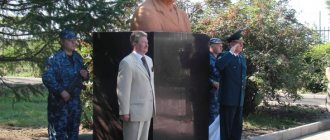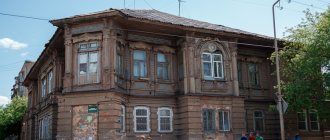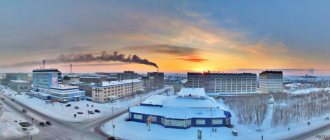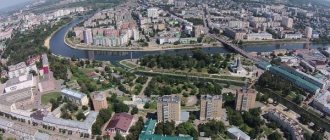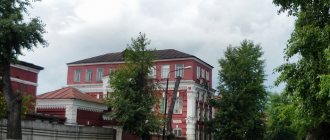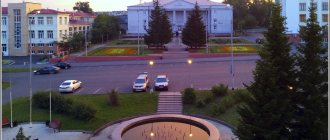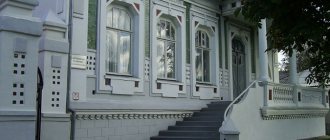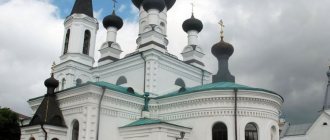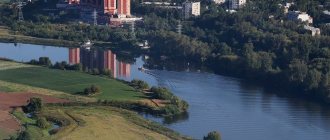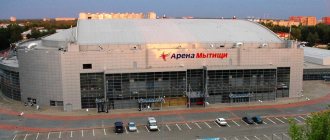The city of Danilov - attractions
The city of Danilov at the present time. This is a small town in the Yaroslavl region on the banks of the Pelenga River. Its population is only 14.5 thousand people. In the east, the Danilovsky district borders the Kostroma region.
The city is a major railway junction. There are 15 railway tracks and a junction station of different types of current - alternating and direct.
View hotels in Danilov on Booking.com =>>
Kazan Cathedral
The most significant architectural monument of Danilov. Located on the outskirts of the city. This cathedral is all that remains of the ensemble of the Kazan Convent. Founded at the end of the 19th century, the monastery constantly experienced financial difficulties. Even the construction of the main cathedral stopped for many years.
The beautiful red brick cathedral was illuminated under Soviet rule - in 1918. Now the cathedral is gradually being restored, protected by the monastic community recreated here. The temple is worth a visit to admire the architecture, unusual for the Yaroslavl land.
Danilovsky Prison Castle
Located in the center of the city. The building was built in the 19th century. Since it was constantly used and repaired until the 2000s, it was well preserved. Thanks to local historians, the prison castle is actively included in the tourist life of Danilov. Although there are no funds for its full restoration.
A visiting tourist without prior arrangement will be able to view the castle only from the outside. By calling the staff of the local history museum, you can count on a sightseeing tour of some of the premises. The guide will tell you that Alexander Solzhenitsyn was kept in the castle for some time and that in the entire history of the prison, only one prisoner escaped from it. The value of the object lies in the fact that throughout Russia there are at most two or three more such prison castles left.
Location: Yaroslavskaya street - 6.
Links[edit]
Notes[edit]
- ^ abcdefg Law No. 12-z
- ^ a b Federal State Statistics Service (2011). “All-Russian Population Census 2010. Volume 1" [All-Russian Population Census 2010, vol. 1]. All-Russian Population Census 2010 [All-Russian Population Census 2010]
. Federal State Statistics Service. - "26. The size of the permanent population of the Russian Federation by municipalities as of January 1, 2022". Federal State Statistics Service. Retrieved January 23, 2022.
- ^ abcd Law No. 65-z
- Federal State Statistics Service. Federal Agency for Technological Regulation and Metrology. No. OK 033-2013 January 1, 2014 “All-Russian classifier of municipal territories. Code 78 615.” (Federal State Statistics Service. Federal Agency for Technological Regulation and Metrology. No. OK 033-2013 January 1, 2014. Russian classification of municipal territories. Code 78 615.
). - "On the Calculation of Time". Official Internet portal of legal information
. June 3, 2011. Retrieved January 19, 2022. - Post office. Information and computing center of OASU RPO. ( Post office
).
Search for postal service objects ( postal Search for objects
) (in Russian) - ↑
Federal State Statistics Service of Russia (May 21, 2004).
“The population of Russia, the constituent entities of the Russian Federation as part of federal districts, urban settlements, settlements, settlements is 3 thousand or more people” [Population of Russia, its federal districts, federal districts, districts Urban settlements, rural settlements - administrative centers and rural settlements with a population of over 3,000] (XLS). All-Russian Population Census 2002
. - “All-Union Population Census of 1989. The current population of union and autonomous republics, autonomous regions and districts, territories, negative phenomena, urban settlements and rural district centers” [All-Union Population Census of 1989: current population of union and autonomous republics, Autonomous regions and districts , territories, regions, districts, towns and villages performing the functions of district administrative centers. All-Union Population Census of 1989 [All-Union Population Census of 1989]
.
Institute of Demography of the National Research University: Higher School of Economics [Institute of Demography of the National Research University: Higher School of Economics]. 1989 - via Demoscope Weekly
.
House of Culture
Today, perhaps, only a specialist or a very experienced lover of antiquities will be able to recognize the former temple in the house of culture of the city of Danilov. There are no domes or under-dome drums; the temple space is divided into floors.
The Resurrection Cathedral, like many churches in our country, was greatly rebuilt, but at least this saved the building from complete destruction. It is known that in 1918 Patriarch Tikhon visited it and held a service. A memorial plaque on the facade of the building tells about this.
Location: Cathedral Square - 7.
Historical and Local Lore Museum named after P.K. Sharapov
For a small town, Danilov has a surprising number of museums—as of recently, as many as three. The local history museum is the oldest, dating back to 1967. The exhibition is very rich and built according to all the canons of museum work. The visitor will learn about the nature of the region, get acquainted with the main milestones in the history of Danilov, learn about the most significant events and distinguished citizens. Much attention is paid to the heroic past and various types of crafts that existed and exist on Danilovsky land. There is a wonderful park next to the museum.
Location: Cathedral Square - 5.
Coat of arms and flag
Main article: Flag of Danilov
Coat of arms of Danilov 1778.
The city's coat of arms was approved, according to some sources, on June 20, and according to others, on August 31, 1778. It is a shield divided in half; one half of it is silver, and the other is checkerboard. A bear with an ax on his shoulder emerges from the chessboard into the silver one - belonging to the Yaroslavl governorship. According to the Hermitage restoration artist P. F. Kalikin, the chess field appeared on the city’s coat of arms in memory of the gift of silver chess from the townspeople to Peter I. According to a historical parable, Peter I once examined Danilov, he did not like many things and he became furious. But Danilov’s people found out about his passion for the game of chess and brought him a chess set with silver pieces, which the tsar liked and was allegedly later exhibited in the Hermitage. The green color represents the rich pasture meadows near the city[7][9].
Railway Junction Museum
In fact, this is a branch of the local history museum, but it has its own building and a unique collection, formed independently of the collection of the main museum. It began as a corporate museum; several years ago the collection was transferred to the local history museum. Which made the museum more accessible.
Visitors are presented with interesting exhibits from the history of the Danilov railway junction starting from the 19th century. The highlight of the museum is an old steam locomotive.
Location: Vyatskaya street - 4.
Danilovskaya Art Gallery
The gallery was founded in 1997. The collection is based on works by local artists and photographers. Not only artists from the cities of the Yaroslavl region, but also from all over the country consider it an honor to exhibit in this gallery. Visitors are constantly offered new exhibitions, excursions and master classes are held in various areas of artistic creativity. The gallery hosts a permanent exhibition and sale.
Location: Volodarsky street - 45.
Shopping arcades
Every Russian city had shopping arcades. Danilov was no exception. In the 70s of the 19th century, the Danilovites managed to replace the old wooden shopping arcades with stone ones. They still exist in the city and are in good condition.
The local population does not have any special reverence for the monument and uses the rows for their intended purpose. There are many shops located here, which means a tourist can not only purchase local and imported goods for himself, but also freely explore the simple interiors of the Trading Rows.
General information about Danilov
The city's economy is based mainly on enterprises related to the railway, forestry and food industries. The forest is one of the main assets of the Danilovsky district - it occupies more than 51% of its territory.
The city's educational institutions include three secondary schools and the Danilovsky Polytechnic College.
During the Great Patriotic War, the city of Danilov was not damaged, so there are many wooden buildings from the century before and last. Among them there are interesting architectural and historical monuments.
St. Nicholas Church
A very interesting temple, located a stone's throw from the Trading Rows. Built in 1910, it is an excellent example of the pseudo-Russian style widespread at that time. The temple resembles more of a fairy-tale tower. It is known that a church existed on this site until the 20th century. The temple is now operational and is being gradually restored.
Location: Karl Marx street - 19a.
Other places
Steam locomotive L-1107. Such monuments to railway workers can be found in many cities, for example, Yaroslavl, Vladimir and Nizhny Novgorod. This iron “horse” designed by Lebedyansky is located next to the railway station.
Danilov Prison Castle. Built in the 60s of the 19th century. Since then, his appearance has not changed. Currently closed to the public.
House of the merchant Kruglikov. Built in the first half of the 19th century. It is an architectural monument marked at the federal level. It looks like a standard merchant's house of that time.
Sovetskaya Square (formerly Torgovaya Square). This is one of the central squares of Danilov. The shopping arcades are located here.
Shopping arcades. Another name is “House of Trade”. Built at the end of the 19th century. Since then they have been used for their intended purpose.
Danilovsky Arbat is a 19th century cobblestone street, opened on the city day. Located next to shopping arcades.
Actor Alexey Makarovich Smirnov was born in Danilov. His film images are well known to us from the films “Operation Y” and “Only Old Men Go to Battle.” The city administration is working to create the Theater House museum, which will be dedicated to the natives of Danilov - Smirnov, Doronina and Lyubimov.
In the meantime, you can find the house where the actor lived for 10 years. There is a commemorative plaque on it. It is located at the intersection of Uritsky and Karl Marx streets.
It is also planned to install a monument to the founder of the city, Prince Daniil of Moscow.
19-36 traffic police. Be careful when entering the city from Yaroslavl. There is a traffic police car parked there. But don't worry too much. This is a rare VAZ 2101 model from 1974. Here he stands on a pedestal. Recommended for viewing and photographing by fans of retro cars.
Such sights came across our path during a trip to Danilov. Have you been here?
Chapel of the Smolensk Icon of the Mother of God
The small wooden chapel appears to be ancient, but in fact it was only built in 1998. It was the idea of Afghan veterans. They decided in this way to perpetuate the memory of the Danilov soldiers who died defending the Fatherland. Currently, the chapel is under the care of the nuns of the Kazan Monastery. There is a commemorative plaque on it.
Location: Lenin street.
Church of the Ascension
One of the few surviving temples in the city. It was built in the middle of the 19th century at the expense of the local merchant Komatovsky. The temple is operational. It is surrounded by a cemetery where the grave of the temple builder is preserved. Experts conclude that the church was built on the model of Moscow churches of the same period.
Location: Yaroslavskaya street - 26.
“MY FAVORITE CITY” presentation
Slide 1
Kondyreva Irina Vladimirovna teacher of the 1st category “My favorite city is Danilov.”
Slide 2
History and geography First mention XV century Previous names before 1777 - the village of Danilovskoye City since 1777 Area of the Moscow Region - 11.82 [1] km² Center height 160 m Time zone UTC+3:00
Slide 3
Population Population ↘ 14,522 people (2020) Density 1210.17 people/km² Katoykonim Danilovets, Danilovtsy Digital identifiers Telephone code +7 48538 Postal codes 152070—152072, 152099 OKATO code 78215501 OKTMO code 786151010 01
Slide 4
Goal: to consolidate knowledge about your hometown and its inhabitants. Objectives: to form patriotic feelings; develop the ability to apply previously acquired knowledge about your hometown in the game; develop memory, attention, reaction speed; consolidate knowledge about your hometown; foster a sense of pride in your hometown.
Slide 5
Rules of the game. The game is designed for 6 people. Children are given cards with pictures of attractions, organizations in the city, WWII heroes born in the city (4 pictures on one card). The presenter (adult) has similar single pictures. The presenter (adult) shows a picture and asks who has such a picture. The child who has such a picture should raise his hand. In order to get this picture, you need to explain what is shown on it and where it is, if it is a WWII hero, name him and say what he knows about him. The winner is the one who is the first to cover all the images on the card and correctly name what is shown on it.
Slide 6
Expected Result. To form in children an idea of their hometown: attractions, organizations available in the city and WWII heroes born in the city.
Slide 7
Card 1
Slide 8
Card 1 (description) 1.Hotel "Sot" 2.Railway station. 3.Music school 4.City administration building
Slide 9
Card 2
Slide 10
Card 2 (description) 1. Military registration and enlistment office 2. Eternal flame 3. Historical and local history museum 4. Shopping arcades
Slide 11
Card 3
Slide 12
Card 3 (description) 1. Cathedral of the Icon of the Kazan Mother of God 2. School market. 3. Secondary school No. 1 4. Temple of the Ascension of the Lord
Slide 13
Historical information Danilov (Yaroslavl region) is located in the central part of the East European Plain on both banks of the small Pelenga River, in close proximity to its source. It is located 351 kilometers northeast of Moscow. Danilov is located in the temperate continental climate zone.
Slide 14
Historical information The village of Danilovskoye was first mentioned in documents from the mid-15th century. Thus, from the charter of Grand Duke Vasily II dated March 20, 1457, it follows that the village of Danilovskoye with the surrounding wastelands (arable lands) belonged to the Metropolitan of All Rus' Jonah of Moscow. Soon, already under the reign of Ivan III, the village changed its owner. As a result of the exchange, it is transferred to the Moscow governor Ivan Dmitrievich Runo (source not specified 3694 days) In 1592 it is mentioned as Danilovskaya Sloboda in the manuscript “The Book of the Verbal Saints of Russia”.
Slide 15
Historical information Increasingly, the name of Danilov as the Danilovsky village or Danilovskaya Sloboda begins to be mentioned in documents from the first half of the 17th century, during the Time of Troubles. In 1607, one of the Polish detachments under the leadership of the Lithuanian nobleman Alexander Lisovsky approached the Danilovskaya Sloboda, began to rob the population, burn houses and buildings in nearby villages, and kill residents. Then the Danilovites organized a militia under the leadership of the boyar Fyodor Sheremetev. A bloody battle took place in which the Poles were defeated. The battle took place across the Pelenda River, to the right of the road leading to Romanov. Since that time this place has been called Povalishka. In 2009, a worship cross and a memorial stone were installed near the battle site.
Slide 16
Historical information At the beginning of December 1608, a detachment of Vologda residents led by Larion Monastyrev, heading towards the “thieves” to Yaroslavl, occupied the Danilovskoye village. The squads set up a fort in it and fortified themselves. Danilovites took an active part in the creation of the fortification. However, this people's militia was poorly organized and could not withstand superior forces. In the same year, the fort was surrounded by Polish troops and, after a short battle, was taken, and the village of Danilovskoye and its surroundings were burned out and devastated. The Nikon Chronicle says that the invaders “killed many honest people.” Many village residents were exterminated. The place where the battle took place and the fort was located has survived to this day - Zemlyanoy Val Street.
Slide 17
Historical information Modern times At the end of the 17th century, the Danilovskoye village became a large settlement with markets and prisons. Under Peter I, there was a stud farm in the settlement that supplied horses for the army. In 1713, the stone Smolensk Cathedral was built to replace the old wooden church (dismantled in the 1940s). The settlement was considered the palace village of Danilov, and the palace Danilovskaya volost was included in the Lyubimsky district of the Kostroma province. In 1777, with the establishment of the Yaroslavl governorship and province, Danilovskaya Sloboda was transformed into the district town of Danilov (officially - August 3, 1777). The opening of the city and public places took place on December 30, 1777. The city was (and is) located on a large road leading from Moscow and Yaroslavl to Vologda and Arkhangelsk, and there was a weekly market there. The population numbered 1,290 people, mostly engaged in trade and craft. There were 278 houses, including four stone ones. In the settlement there were several handicraft workshops, a copper samovar factory with 35 employees, two wax factories, three candle factories, and three dye factories. There were two parish schools, which annually graduated 35-40 people, three churches, two of which were wooden.
Slide 18
Historical information In 1787, there were already 357 residential buildings, 115 shops, 8 forges in Danilov, and the number of enterprises increased. The city at that time had a diameter of 1 km. Danilov and its surroundings, from the “Atlas of the Yaroslavl Province” of 1858 The importance of the city as a stop on the way from Moscow to Arkhangelsk grew. Residents were engaged in latrine farming, arable farming and gardening. The city was famous for the sale of canvas, which was bought up from the surrounding population on market days and sent to St. Petersburg and Moscow. Horses, cattle, and manufactured goods were sold at the fair. In 1864, two parochial schools were opened: one for boys (about 30 students) and one for girls (less than 20 places). In the middle of the 19th century, there were 9 factories in the city: 2 samovar and candle factories, a brick factory, a leather factory, a molasses factory, a brewery factory and a gingerbread factory. All together they produced products worth up to 250 thousand rubles. in year. Local copper factories produced samovars, coffee pots, teapots and other copper utensils that were sent to the capitals. Molasses was sold at the Nizhny Novgorod and Rostov fairs.
Slide 19
Historical information In 1870, a project was approved for the construction of the Yaroslavl-Vologda narrow-gauge railway (later rebuilt into a broad-gauge railway), which, at the request of townspeople and local authorities, was built near the city itself on land unsuitable for cultivation called “Goat Swamp”. On January 29, 1870, construction began on the station building: a wooden one with a small waiting room and kerosene lighting. In January 1872, passenger traffic opened from Danilov to Yaroslavl, and in June - from Danilov to Vologda. More than 300 people passed along the road every day. The passenger train from Danilov to the Yaroslavl station Uroch took about 4 hours. In 1873, there were 14 taverns and 36 taverns in the city. There were 20 kerosene lanterns and 2 stone-paved streets. A large stone building for shops was built on the market square. The alleys around Preobrazhensky Pond, which has now been destroyed, and the station, especially when trains arrived, served as a place for townspeople to walk. In 1892, 3,616 people lived in Danilov; of all industrial enterprises, including small ones, there were 12[. In 1895, the city was almost completely destroyed by fire. In 1910, the city had 1 hospital with 30 beds, 2 pharmacies, 2 doctors, 3 paramedics, 4 craft institutions, 6 lower educational institutions with 464 students. There were no theaters, libraries, or secondary educational institutions. In 1917, the city had 13 streets and less than 5 thousand inhabitants. In 1918, the Danilov-Bui section of the railway came into operation.
Slide 20
Historical information Modern times In 1930, a new railway station was built in the constructivist style. In 1941, the Danilovsky woodworking machinery plant was built - at that time the only one in the country that also worked for export.

